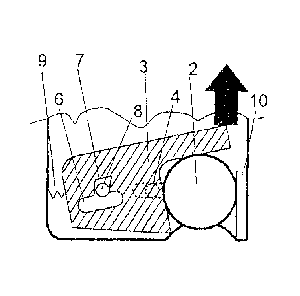Some of the information on this Web page has been provided by external sources. The Government of Canada is not responsible for the accuracy, reliability or currency of the information supplied by external sources. Users wishing to rely upon this information should consult directly with the source of the information. Content provided by external sources is not subject to official languages, privacy and accessibility requirements.
Any discrepancies in the text and image of the Claims and Abstract are due to differing posting times. Text of the Claims and Abstract are posted:
| (12) Patent: | (11) CA 2605529 |
|---|---|
| (54) English Title: | DEPOSIT LOCK |
| (54) French Title: | SERRURE A CONSIGNE |
| Status: | Granted and Issued |
| (51) International Patent Classification (IPC): |
|
|---|---|
| (72) Inventors : |
|
| (73) Owners : |
|
| (71) Applicants : |
|
| (74) Agent: | SMART & BIGGAR LP |
| (74) Associate agent: | |
| (45) Issued: | 2014-04-29 |
| (86) PCT Filing Date: | 2005-03-16 |
| (87) Open to Public Inspection: | 2006-09-21 |
| Examination requested: | 2007-09-13 |
| Availability of licence: | N/A |
| Dedicated to the Public: | N/A |
| (25) Language of filing: | English |
| Patent Cooperation Treaty (PCT): | Yes |
|---|---|
| (86) PCT Filing Number: | PCT/DE2005/000474 |
| (87) International Publication Number: | DE2005000474 |
| (85) National Entry: | 2007-09-13 |
| (30) Application Priority Data: | None |
|---|
The invention relates to a deposit lock comprising a checking element which
controls the diameter of an inserted deposit element with respect to the
available value thereof and a key holding element, wherein said holding
element releases the key when the value is available.
La présente invention concerne une serrure à consigne comprenant un élément de vérification qui contrôle le diamètre de l'élément de consigne inséré quant à la validité de sa valeur, ainsi que des éléments de retenue pour une clé. Les éléments de retenue ne libèrent la clé que si la valeur est valable.
Note: Claims are shown in the official language in which they were submitted.
Note: Descriptions are shown in the official language in which they were submitted.

2024-08-01:As part of the Next Generation Patents (NGP) transition, the Canadian Patents Database (CPD) now contains a more detailed Event History, which replicates the Event Log of our new back-office solution.
Please note that "Inactive:" events refers to events no longer in use in our new back-office solution.
For a clearer understanding of the status of the application/patent presented on this page, the site Disclaimer , as well as the definitions for Patent , Event History , Maintenance Fee and Payment History should be consulted.
| Description | Date |
|---|---|
| Common Representative Appointed | 2019-10-30 |
| Common Representative Appointed | 2019-10-30 |
| Change of Address or Method of Correspondence Request Received | 2018-01-12 |
| Inactive: Correspondence - Prosecution | 2018-01-04 |
| Small Entity Declaration Determined Compliant | 2018-01-04 |
| Small Entity Declaration Request Received | 2017-09-25 |
| Small Entity Declaration Determined Compliant | 2017-09-25 |
| Small Entity Declaration Request Received | 2017-09-25 |
| Letter Sent | 2017-08-29 |
| Letter Sent | 2017-08-29 |
| Inactive: Multiple transfers | 2017-08-09 |
| Grant by Issuance | 2014-04-29 |
| Inactive: Cover page published | 2014-04-28 |
| Pre-grant | 2014-01-10 |
| Inactive: Final fee received | 2014-01-10 |
| Notice of Allowance is Issued | 2013-08-13 |
| Letter Sent | 2013-08-13 |
| Notice of Allowance is Issued | 2013-08-13 |
| Inactive: Approved for allowance (AFA) | 2013-07-15 |
| Amendment Received - Voluntary Amendment | 2013-02-26 |
| Inactive: S.30(2) Rules - Examiner requisition | 2012-08-31 |
| Amendment Received - Voluntary Amendment | 2011-12-29 |
| Inactive: S.30(2) Rules - Examiner requisition | 2011-06-30 |
| Amendment Received - Voluntary Amendment | 2010-11-15 |
| Inactive: S.30(2) Rules - Examiner requisition | 2010-05-14 |
| Letter Sent | 2010-03-11 |
| Reinstatement Requirements Deemed Compliant for All Abandonment Reasons | 2010-02-18 |
| Deemed Abandoned - Failure to Respond to Maintenance Fee Notice | 2009-03-16 |
| Inactive: Cover page published | 2008-01-21 |
| Inactive: Acknowledgment of national entry - RFE | 2008-01-17 |
| Letter Sent | 2008-01-17 |
| Inactive: Inventor deleted | 2008-01-17 |
| Inactive: First IPC assigned | 2007-11-16 |
| Application Received - PCT | 2007-11-15 |
| National Entry Requirements Determined Compliant | 2007-09-13 |
| Request for Examination Requirements Determined Compliant | 2007-09-13 |
| All Requirements for Examination Determined Compliant | 2007-09-13 |
| National Entry Requirements Determined Compliant | 2007-09-13 |
| Application Published (Open to Public Inspection) | 2006-09-21 |
| Abandonment Date | Reason | Reinstatement Date |
|---|---|---|
| 2009-03-16 |
The last payment was received on 2014-02-20
Note : If the full payment has not been received on or before the date indicated, a further fee may be required which may be one of the following
Patent fees are adjusted on the 1st of January every year. The amounts above are the current amounts if received by December 31 of the current year.
Please refer to the CIPO
Patent Fees
web page to see all current fee amounts.
Note: Records showing the ownership history in alphabetical order.
| Current Owners on Record |
|---|
| FRANZ WIETH |
| ANDREAS FILOSI |
| Past Owners on Record |
|---|
| HORST SONNENDORFER |